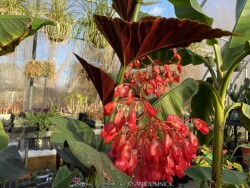

***Description for this plant available with future update!***Angel Wing Begonia (Tropical), is also known as Begonia x coralline
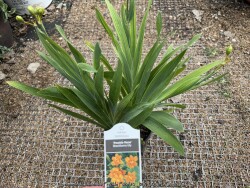

***Description for this perennial available with future update!*** Belamcanda chinensis 'Freckle Face' is also known as Freckle Face Blackberry Lily.


***Description for this perennial available with future update!*** Belamcanda chinensis / Iris domestica is also known as Blackberry Lily.
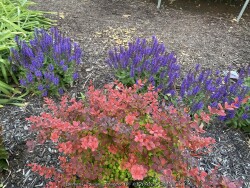

Bright and cheery, this new barberry (Berberis 'Sunjoy Tangelo') has vivid orange new growth that develops a distinctive chartreuse margin as the season goes on. Sunjoy® Tangelo Barberry is stronger growing than other variegated cultivars, it is colorful in the landscape from spring to fall. Certified wheat-rust resistant. Maintenance Notes: Prefers well-drained soils. May be pruned to shape in summer. In Eastern Kansas, this cultivar performs WELL with just about everything nature has to challenge it! Heat and drought are tolerated well. Cold tolerance is no problem. No disease or pest problems. Great plant for berms in full sun. No other plant can match its bright orange-red foliage: I personally love the combination of planting next to blue or purple flowers but the combinations are endless! All Proven Winners® plants are legally propagated, healthy and vigorous, true to name, and tagged with color pictures and growing information.
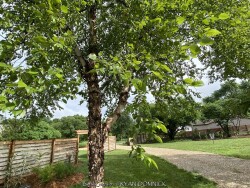

***Tree descriptions available with future update!***River Birch, is also known as Betula nigra
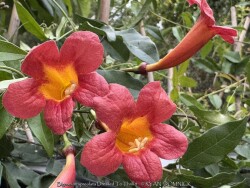

Crossvine (Bignonia capreolata) is a highly ornamented evergreen vine native to the southeast west to Oklahoma and Texas. Fantastic blooms completely cover the plant and occur on old wood in the late spring for about 3-5 weeks then sporadically during the summer. Flowers are trumpet-shaped, orange and red with yellow throats. Although in the same family as trumpet vine (campus radicans), crossvine is not invasive. Plant crossvine on fences or pergolas where you want good coverage but not anything sprawling too far away from the structure needing pruning. Considered to be one of the lowest maintenance of all vines. Crossvine prefer for part to full sun on in medium to rich soils and are able to tolerate drought and brief flooding once established. There are no serious pests or diseases to worry about. Crossvine has thrived in our Lawrence Kansas zone 6a display garden for over 15 years enduring a few occasions of -10° or colder winters. Winter foliage turns purple and remains evergreen till about -10. We have seen -18° without any dieback on the vine other than the loss of foliage that year. This great vine has it all, beautiful flowers, evergreen foliage, and constrained growth habit! Dressed To Thrill Crossvine (Bignonia capreolata 'Dressed To Thrill') is colorful, extremely floriferous, and amazingly adaptable! his selection of our North American native crossvine transforms fences, walls, and trellises into a wall of flowers, climbing structures by tendrils. Orange-red trumpet-shaped flowers with bright yellow eyes enliven landscapes from spring through summer and provide a welcome food source for hummingbirds. Native from Ohio down to Texas, this semi-evergreen vine is adaptable to most any soil and exhibits excellent heat and drought tolerance.
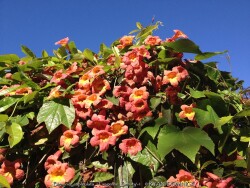

Crossvine (Bignonia capreolata) is a highly ornamented evergreen vine native to the southeast west to Oklahoma and Texas. Fantastic blooms completely cover the plant and occur on old wood in the late spring for about 3-5 weeks then sporadically during the summer. Flowers are trumpet-shaped, orange and red with yellow throats. Although in the same family as trumpet vine (campus radicans), crossvine is not invasive. Plant crossvine on fences or pergolas where you want good coverage but not anything sprawling too far away from the structure needing pruning. Considered to be one of the lowest maintenance of all vines. Crossvine prefer for part to full sun on in medium to rich soils and are able to tolerate drought and brief flooding once established. There are no serious pests or diseases to worry about. Crossvine has thrived in our Lawrence Kansas zone 6a display garden for over 15 years enduring a few occasions of -10° or colder winters. Winter foliage turns purple and remains evergreen till about -10. We have seen -18° without any dieback on the vine other than the loss of foliage that year. This great vine has it all, beautiful flowers, evergreen foliage, and constrained growth habit! Bignonia capreolata 'Tangerine Beauty' is noted for its tangerine flowers and slightly improved cold hardiness.
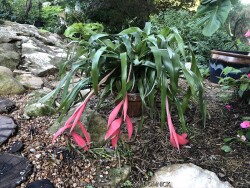

***Description for this plant available with future update!***Billbergia Bromeliad / Friendship Plant (Tropical), is also known as Billbergia nutans
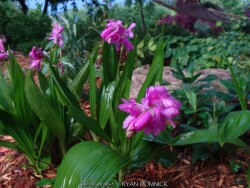

Hardy Ground Orchid (Bletilla striata) is planted for its attractive green foliage with and amazing spring flower display of pink and magenta "orchid-like" flowers. Foliage maintains well all season provided that certain cultural conditions are met. Native to Chinese forests with humusy, well-drained soil in part shade to full shade, it needs constantly moist to average soil rich in organic matter but avoid clay. If low temperatures hit -10 degrees F, it may kill an un-mulched plant; protect any zone 6 perennial with thick layer of mulch. I have occasionally seen entire plantings wiped out at -10 to15 degrees F with no mulch or snow cover. Good late summer flowering shade plant which mixes well with hostas and ferns in the shade garden. Generally this plant has declined after a few years in our Kansas display garden but worth a try in perfect soils in well-tended shade gardens.
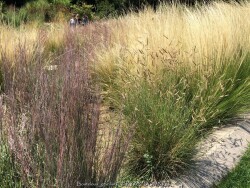

Blue Grama Grass (Bouteloua gracilis) is a long-lived, clump-forming, warm-season, perennial grass native to North America. It is one of the dominant grasses of the dry shortgrass prairies. Blue grama has very thin green to greyish leaves that turn golden brown in autumn, sometimes also developing interesting shades of orange. Purplish-tinged eyebrow-shaped flowers appear on arching stems above the foliage in early to mid-summer. Height before flowering is 12-15" increasing to 24" after flowering. As a native to the Great Plains, blue grama displays excellent drought tolerance but tolerates a wide range of soils. Avoid poorly-drained soils. In Eastern Kansas, typically our 40 inches of rainfall is sufficient without extra water. Occasionally suffering from excessive rainy spells and high humidity, foliage rust diseases can be a problem in shade or poor air circulation areas. To counteract that in Kansas, plant in full sun on berm with poor sandy, rocky, or clay soil with no irrigation. Blue grama grass works very well in an ornamental grass garden adding contrast, texture, and short stature. Use as mass plantings to create a drift that can be enjoyed from far away. For mass plantings, plant individual plants close together as they don't spread much. Dried foliage holds up very well in the winter offering a one-of-a-kind look. The only maintenance is to cut down or burn before new growth emerges. Combine with other flowering prairie native perennials for a long season of interest. Also useful as a full-sun turf grass for extremely dry or sandy soils or where buffalo grass doesn't work. It can be regularly mowed to 3-4" high.
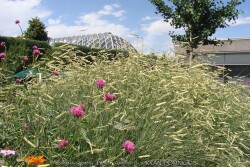

Blonde Ambition Blue Grama Grass (Bouteloua gracilis 'Blonde Ambition') is a long-lived, clump-forming, warm-season, perennial grass native to North America. It is one of the dominant grasses of the dry shortgrass prairies. Blue grama has very thin green to greyish leaves that turn golden brown in autumn, sometimes also developing interesting shades of orange. Chartreuse eyebrow-shaped flowers appear on arching stems above the foliage in early to mid-summer. Height before flowering is 12-18" increasing to 24-30" after flowering. The seed heads form a dense, compact, but airy look turning a bright blonde color in fall and winter. As a native to the Great Plains, blue grama displays excellent drought tolerance but tolerates a wide range of soils. Avoid poorly-drained soils. In Eastern Kansas, typically our 40 inches of rainfall is sufficient without extra water. Occasionally suffering from excessive rainy spells and high humidity, foliage rust diseases can be a problem in shade or poor air circulation areas. To counteract that in Kansas, plant in full sun on berm with poor sandy, rocky, or clay soil with no irrigation. Blue grama grass works very well in an ornamental grass garden adding contrast, texture, and short stature. Use as mass plantings to create a drift that can be enjoyed from far away. For mass plantings, plant individual plants close together as they don't spread much. Dried foliage holds up very well in the winter offering a one-of-a-kind look. The only maintenance is to cut down or burn before new growth emerges. Combine with other flowering prairie native perennials for a long season of interest. Also useful as a full-sun turf grass for extremely dry or sandy soils or where buffalo grass doesn't work. It can be regularly mowed to 3-4" high.
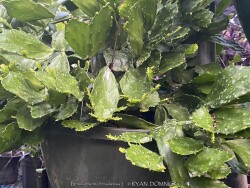

The Brazilian Prickly Pear, also known as Brasiliopuntia brasiliensis, is a tree-like species of cacti from Brasil. It produces thin, flat, succulent leaves that resemble a prickly pear but much less thick. Originating from a dry climates but not a true desert, it is much more moisture tolerant than a typical derert barrel cactus. The main ornamental appeal is the beautiful bright green leaves (actually pads) These are popular house plants because of the ease of care, flexibility when moving in or outside for the season, and both drought and moisture tolerance. This tropical cactus has a few requirements in order to thrive but nothing too hard. Give them bright indirect light and water only when dry. If light, temperature, and humidity are sufficient, flowers may occur. If not, then just enjoy the beautiful foliage. Succulents are usually spineless and grown for their beautiful shapes, color and texture. Cacti are known for their spines, unusual shapes and beautiful flowers. Both succulents and cacti store water in their fleshy tissues. And can survive long periods without water. Cacti and succulents are usually grown as a deck/patio plant or house plant in Kansas. Grow in full sun with little to no extra watering except that which comes from rainfall. Generally, plants may be brought out in Late May through Early October in our zone 6a Lawrence, KS climate. To play is safe, potted plants are best moved in before autumn leaves begin to drop and before night temperatures get below 45 degrees F. It is very important to avoid the combination of wet and cold. Move to a bright interior window over the winter with little to no watering and keep above 50 degrees F. As a winter house plant, it will look presentable all winter long with little to no waterings. As a permanent house plant, provide bright light and allow the soil to dry completely between waterings and you will get many years of carefree enjoyment. Plants grown permanently indoors may eventually begin to elongate stretching for light and lose their spine color. It can be hard to reproduce the intense UV sunlight they need when growing indoors so moving outside for the summer is best. Generally if moving outside for the summer, allow 1-2 weeks of part shade or morning sun before placing in full sun. Plants with time to acclimate will thrive in full sun but be careful not to rush it or sunburning may occur. Repotting may or may not be needed depending on how large you want the plant to grow; plants can continue to grow taller and tolerate extremely root-bound pots but may need wind bracing. If repotting, make sure to use a sharp draining low organic cactus mix with plenty of sand and perlite but avoid peat moss. The “soil” most commercial cacti are potted in to too peaty and light weight. This soil becomes hydrophobic and shrinks after becoming bone dry and difficult to re wet again. Cacti never grow in peat-based soils in nature; this “Soil” is only good for shipping because of the light weight. Potted plants are very low maintenance but watch for scale and mealybugs that may hide beneath the cover of spines. The best pest removal approach is to periodically wash the cactus off. Achieve this with a water nozzle or hose breaker turned mostly off to increase the pressure from the blast of water. This high-pressured water kills the pests without damaging the thick cactus skin. Here are some little-known or rare factoids about cacti: 1. The "spines" are actually modified leaves filled with sap at first, then quickly drying out to form the spines! 2. Many cacti have bright colored flowers that mainly attract bees, while some tubular flowering types attract hummingbirds and bats. 3. Late on the evolutionary timeline, cacti fossils are rare to non-existent. Cacti are native almost exclusively to the Americas, while succulents can include a much larger plant palette be from any dry area in the world. 4. Some cactus plants have been known to survive more than 2 years without water. 5. Some cacti first evolved in a dry climate that later became wetter again. For example: several jungle species live as epiphytes in trees to achieve the fast drainage they need.


Brugmansia is a genus of seven species of flowering plants in the nightshade family Solanaceae from South America. It is typically grown in warmer zones as a shrub or tree but is extinct from the wild (only known in cultivation). Along with other tropicals and succulents in Kansas, Angel Trumpet Flower is usually grown as summer patio plant with amazing foot-long hanging flowers and sweet aroma. Water regularly and place in full sun or part shade. Protect from temperatures below 32 degrees F and move into a cold garage or basement over the winter with minimal watering. Do not allow the pot with rootball to freeze solid or go below 28 degrees for more than a few hours. Allow to go dormant as needed with little care, just cut off dead foliage/twigs and place back out in April or May with a time-release fertilizer. You may also propagate this plant easily by cutting off dormant twigs/branches and stuffing them into the ground. Notice that I didn't say rooting hormone or even being careful was necessary! Landscapers also plant these as an annual in the ground for an enormous tropical effect with fragrant flowers and growth reaching 5-8' in one season from a 1gal container! It is possible to overwinter Brugmansia in the ground in Kansas as a woody perennial. In our trial gardens in Lawrence, KS (zone 6a), a one year established specimen planted in our annual bed was mulched 12-18" thick with leaf mulch survived -10 degrees F. The dieback was deep into the ground but somehow came back from a piece of deep root. The leaf mulch was also well rotted and formed somewhat of an ice barrier insulating effect. Brugmansia species are amongst the most toxic of ornamental plants so do not eat and part of this plant! Brugmansia 'Charles Grimaldi' features orange flowers.
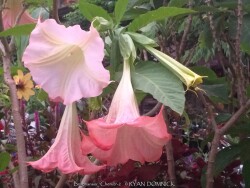

Brugmansia is a genus of seven species of flowering plants in the nightshade family Solanaceae from South America. It is typically grown in warmer zones as a shrub or tree but is extinct from the wild (only known in cultivation). Along with other tropicals and succulents in Kansas, Angel Trumpet Flower is usually grown as summer patio plant with amazing foot-long hanging flowers and sweet aroma. Water regularly and place in full sun or part shade. Protect from temperatures below 32 degrees F and move into a cold garage or basement over the winter with minimal watering. Do not allow the pot with rootball to freeze solid or go below 28 degrees for more than a few hours. Allow to go dormant as needed with little care, just cut off dead foliage/twigs and place back out in April or May with a time-release fertilizer. You may also propagate this plant easily by cutting off dormant twigs/branches and stuffing them into the ground. Notice that I didn't say rooting hormone or even being careful was necessary! Landscapers also plant these as an annual in the ground for an enormous tropical effect with fragrant flowers and growth reaching 5-8' in one season from a 1gal container! It is possible to overwinter Brugmansia in the ground in Kansas as a woody perennial. In our trial gardens in Lawrence, KS (zone 6a), a one year established specimen planted in our annual bed was mulched 12-18" thick with leaf mulch survived -10 degrees F. The dieback was deep into the ground but somehow came back from a piece of deep root. The leaf mulch was also well rotted and formed somewhat of an ice barrier insulating effect. Brugmansia species are amongst the most toxic of ornamental plants so do not eat and part of this plant! Brugmansia 'Cherub' features bright pink flowers.
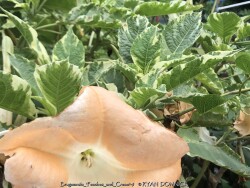

Brugmansia is a genus of seven species of flowering plants in the nightshade family Solanaceae from South America. It is typically grown in warmer zones as a shrub or tree but is extinct from the wild (only known in cultivation). Along with other tropicals and succulents in Kansas, Angel Trumpet Flower is usually grown as summer patio plant with amazing foot-long hanging flowers and sweet aroma. Water regularly and place in full sun or part shade. Protect from temperatures below 32 degrees F and move into a cold garage or basement over the winter with minimal watering. Do not allow the pot with rootball to freeze solid or go below 28 degrees for more than a few hours. Allow to go dormant as needed with little care, just cut off dead foliage/twigs and place back out in April or May with a time-release fertilizer. You may also propagate this plant easily by cutting off dormant twigs/branches and stuffing them into the ground. Notice that I didn't say rooting hormone or even being careful was necessary! Landscapers also plant these as an annual in the ground for an enormous tropical effect with fragrant flowers and growth reaching 5-8' in one season from a 1gal container! It is possible to overwinter Brugmansia in the ground in Kansas as a woody perennial. In our trial gardens in Lawrence, KS (zone 6a), a one year established specimen planted in our annual bed was mulched 12-18" thick with leaf mulch survived -10 degrees F. The dieback was deep into the ground but somehow came back from a piece of deep root. The leaf mulch was also well rotted and formed somewhat of an ice barrier insulating effect. Brugmansia species are amongst the most toxic of ornamental plants so do not eat and part of this plant! Brugmansia 'Peaches and Cream' features white and green variegated foliage and light orange flowers.
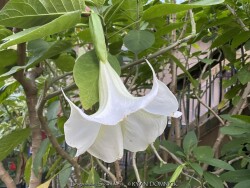

Brugmansia is a genus of seven species of flowering plants in the nightshade family Solanaceae from South America. It is typically grown in warmer zones as a shrub or tree but is extinct from the wild (only known in cultivation). Along with other tropicals and succulents in Kansas, Angel Trumpet Flower is usually grown as summer patio plant with amazing foot-long hanging flowers and sweet aroma. Water regularly and place in full sun or part shade. Protect from temperatures below 32 degrees F and move into a cold garage or basement over the winter with minimal watering. Do not allow the pot with rootball to freeze solid or go below 28 degrees for more than a few hours. Allow to go dormant as needed with little care, just cut off dead foliage/twigs and place back out in April or May with a time-release fertilizer. You may also propagate this plant easily by cutting off dormant twigs/branches and stuffing them into the ground. Notice that I didn't say rooting hormone or even being careful was necessary! Landscapers also plant these as an annual in the ground for an enormous tropical effect with fragrant flowers and growth reaching 5-8' in one season from a 1gal container! It is possible to overwinter Brugmansia in the ground in Kansas as a woody perennial. In our trial gardens in Lawrence, KS (zone 6a), a one year established specimen planted in our annual bed was mulched 12-18" thick with leaf mulch survived -10 degrees F. The dieback was deep into the ground but somehow came back from a piece of deep root. The leaf mulch was also well rotted and formed somewhat of an ice barrier insulating effect. Brugmansia species are amongst the most toxic of ornamental plants so do not eat and part of this plant! Brugmansia 'Snowflake' features pure white flowers. Our plant came from Brian's Botanicals in Kentucky.
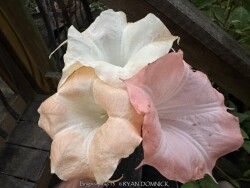

Brugmansia is a genus of seven species of flowering plants in the nightshade family Solanaceae from South America. It is typically grown in warmer zones as a shrub or tree but is extinct from the wild (only known in cultivation). Along with other tropicals and succulents in Kansas, Angel Trumpet Flower is usually grown as summer patio plant with amazing foot-long hanging flowers and sweet aroma. Water regularly and place in full sun or part shade. Protect from temperatures below 32 degrees F and move into a cold garage or basement over the winter with minimal watering. Do not allow the pot with rootball to freeze solid or go below 28 degrees for more than a few hours. Allow to go dormant as needed with little care, just cut off dead foliage/twigs and place back out in April or May with a time-release fertilizer. You may also propagate this plant easily by cutting off dormant twigs/branches and stuffing them into the ground. Notice that I didn't say rooting hormone or even being careful was necessary! Landscapers also plant these as an annual in the ground for an enormous tropical effect with fragrant flowers and growth reaching 5-8' in one season from a 1gal container! It is possible to overwinter Brugmansia in the ground in Kansas as a woody perennial. In our trial gardens in Lawrence, KS (zone 6a), a one year established specimen planted in our annual bed was mulched 12-18" thick with leaf mulch survived -10 degrees F. The dieback was deep into the ground but somehow came back from a piece of deep root. The leaf mulch was also well rotted and formed somewhat of an ice barrier insulating effect. Brugmansia species are amongst the most toxic of ornamental plants so do not eat and part of this plant! Flowers come in Orange, Red, Pink, and White.
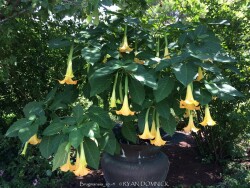

Brugmansia is a genus of seven species of flowering plants in the nightshade family Solanaceae from South America. It is typically grown in warmer zones as a shrub or tree but is extinct from the wild (only known in cultivation). Along with other tropicals and succulents in Kansas, Angel Trumpet Flower is usually grown as summer patio plant with amazing foot-long hanging flowers and sweet aroma. Water regularly and place in full sun or part shade. Protect from temperatures below 32 degrees F and move into a cold garage or basement over the winter with minimal watering. Do not allow the pot with rootball to freeze solid or go below 28 degrees for more than a few hours. Allow to go dormant as needed with little care, just cut off dead foliage/twigs and place back out in April or May with a time-release fertilizer. You may also propagate this plant easily by cutting off dormant twigs/branches and stuffing them into the ground. Notice that I didn't say rooting hormone or even being careful was necessary! Landscapers also plant these as an annual in the ground for an enormous tropical effect with fragrant flowers and growth reaching 5-8' in one season from a 1gal container! It is possible to overwinter Brugmansia in the ground in Kansas as a woody perennial. In our trial gardens in Lawrence, KS (zone 6a), a one year established specimen planted in our annual bed was mulched 12-18" thick with leaf mulch survived -10 degrees F. The dieback was deep into the ground but somehow came back from a piece of deep root. The leaf mulch was also well rotted and formed somewhat of an ice barrier insulating effect. Brugmansia species are amongst the most toxic of ornamental plants so do not eat and part of this plant! Flowers come in Orange, Red, Pink, and White.
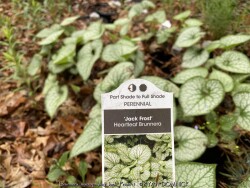

***Description for this perennial available with future update!*** Brunnera macrophylla 'Jack Frost' is also known as Jack Frost Brunnera / Siberian Bugloss.
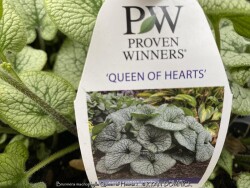

***Description for this perennial available with future update!*** Brunnera macrophylla 'Queen of Hearts'' is also known as Queen of Hearts Brunnera / Siberian Bugloss.
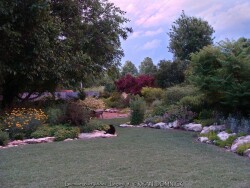

Tired of mowing and maintaining that water thirsty lawn? In our quest to be environmentally friendly and save water, we promote Legacy Buffalograss Lawns (Buchloe dactyloides 'Legacy'tm). Buffalograss has survived for millions of years, through droughts, floods and insect invasions. It is the only turfgrass that is native to the United States. Buffalograss has a very low water requirement and a deep root system that allows it to draw water from a large area. Buffalograss thrives on only 1/4 inch of water per week to stay green. Water savings with buffalograss is astounding. Over one million gallons of water can be saved on every turf acre every year by replacing a high water-use turfgrass, like bluegrass, with buffalograss. We feel the conservation of water is a must for all of us, but we must also reduce our dependency on excess chemicals and the need for the weekly ritual of mowing. Lawnmowers are one of the worst sources of air pollution we breath. Legacy buffalograss can be mowed only once every 2 to 3 weeks. Since this variety has such a short maximum height, many people choose to leave their lawns un-mowed at 4-6". ADVANTAGES OF LEGACY BUFFALO GRASS OVER OTHER LAWNS; 1. Buffalograss is the real "Green" lawn. It has environmental and economic traits that cannot be disputed. A typical homeowner will save hundreds of dollars a year on lawn maintenance costs. Large turf installations can save thousands of dollars. 2.Buffalograss requires much less mowing maintenance and in some situations, none. 3.Fewer weed problems occur; the dense growth of buffalo grass smothers out existing weeds and prevents the germination of new seeds. 4. Minimal lawn treatment program of only 3-5 visits is recommended (fescue & bluegrass lawns require 5-7 visits). 5. Buffalograss requires less water; and will survive with no supplemental irrigation. 6. Buffalograss has high wildlife value; it is native to the great plains of USA. 7. The soft texture and mint green color are great assets; its fun to walk on. 8. Buffalograss grows in zones 3-9; tolerates cold in the winter and heat in the summer. 8. Insect, disease and thatch build-up problems rarely occur in buffalograss lawns. 9. Buffalograss is tolerant of a wide range of soil types but prefers heavy clay. 10. Buffalograss can by divided by plugs to fill in damaged or new areas; can't be seeded. "SO WHY DOESN'T EVERYONE USE BUFFALOGRASS?" (DISADVANTAGES); 1.Buffalograss requires a higher upfront cost and more maintenance during the first year to get it established. Unfortunately, most people only consider the sticker shock of the initial cost. It takes 2-3 years for buffalo grass to pay for itself before savings occur. 2.Most landscape and lawn companies do not promote buffalo grass because they are in business to make money maintaining your lawn. Why would a lawn mowing company promote a lawn that doesn't need much mowing? Why would an irrigation company promote a lawn that didn't need an irrigation system? With few industry professionals promoting it, the true benefits remain unknown to the consumer. 3. Most landscape and lawn companies are not educated about buffalograss nor have the experience to successfully install, establish, and maintain buffalograss from plugs. 4. Buffalograss has a few limitations about where it will grow: it needs full sun, it will not grow in wet areas with poor drainage, and it needs a clay-based topsoil; no sand. 5. Buffalograss goes dormant sooner in late fall and greens up later in the spring.
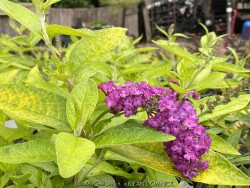

Butterfly Bush (Buddleia) are workhorses in the pollinator garden. Flower panicles come in a variety of colors mostly including shades of lavender, magenta, violet, pink, and white. Most Butterfly Bushes bloom on new wood so trimming off winter kill or complete rejuvenation will not affect flowering. In fact, flowering is often bigger and bolder from new water sprout growth when trimmed to the ground each year. Most Butterfly Bushes in zone 6 are maintained this way. Foliage is typically an attractive greenish-gray to mint green and persists into the fall until hard freezes occur. Use in the landscape in small or large groupings for its amazing flower power! Plants grow best in full sun with medium to dry soils. Drought tolerance is high with established plants so extra watering is rarely needed in our East Kansas climate with 40 inches of rain per year. Obviously, Butterfly Bush attracts lots of butterflies. There has been some debate in recent years on whether to plant Butterfly Bush because it's a non-native plant. Being a native of China, it has no pest or disease problems here. It is invasive in some parts of the country but cold Kansas winters keep it and check and without any self-seeding problems here. If you are still worried about it, there are several sterile varieties to choose from. There have been many drastically improved cultivars in the last 10 years aiming to improve cold hardiness, bloom size, eliminate seeding, and improve growth habits. Buddleia 'Crown Jewels' was developed by Walters Gardens, Inc. It is a new addition to the popular MONARCH® Butterfly Bush collection! Grow this Butterfly Bush for its beautiful gold foliage which shines brightly from spring through fall, easily taking the place of a compact shrub in the landscape. As an added bonus, sharply contrasting, magenta purple flowers sparkle like jewels against the dense, golden foliage, pointing skyward on branched stems from late summer through early fall. Secondary flowers extend the show even further into fall. In Eastern Kansas, 'Crown Jewels' has performs WELL for over 3 years with just about everything nature has to challenge it! Combine with caryopteris and crapemyrtle to create a late season "all you can eat" buffet for pollinators! The MONARCH® trademark is owned by Walters Gardens, Inc.
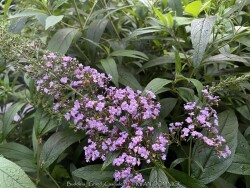

Butterfly Bush (Buddleia) are workhorses in the pollinator garden. Flower panicles come in a variety of colors mostly including shades of lavender, magenta, violet, pink, and white. Most Butterfly Bushes bloom on new wood so trimming off winter kill or complete rejuvenation will not affect flowering. In fact, flowering is often bigger and bolder from new water sprout growth when trimmed to the ground each year. Most Butterfly Bushes in zone 6 are maintained this way. Foliage is typically an attractive greenish-gray to mint green and persists into the fall until hard freezes occur. Use in the landscape in small or large groupings for its amazing flower power! Plants grow best in full sun with medium to dry soils. Drought tolerance is high with established plants so extra watering is rarely needed in our East Kansas climate with 40 inches of rain per year. Obviously, Butterfly Bush attracts lots of butterflies. There has been some debate in recent years on whether to plant Butterfly Bush because it's a non-native plant. Being a native of China, it has no pest or disease problems here. It is invasive in some parts of the country but cold Kansas winters keep it and check and without any self-seeding problems here. If you are still worried about it, there are several sterile varieties to choose from. There have been many drastically improved cultivars in the last 10 years aiming to improve cold hardiness, bloom size, eliminate seeding, and improve growth habits. Buddleia 'Grand Cascade' is an introduction by Walters Gardens, Inc. Unlike the typical Butterfly Bush, the panicles on this flowering shrub cascade downward, similar to the look of weeping willow or a bridalwreath spirea. Light lavender purple flower panicles are enormous at 12-14" long and 4" thick. They're nearly the size of your head! In Eastern Kansas, 'Grand Cascade' has performs WELL for over 3 years with just about everything nature has to challenge it! This is a larger Butterfly Bush growing to 5-6' but still dense and compact in appearance. Combine with caryopteris and crapemyrtle to create a late season "all you can eat" buffet for pollinators!
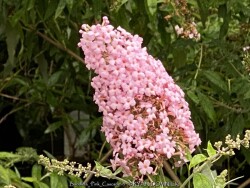

Butterfly Bush (Buddleia) are workhorses in the pollinator garden. Flower panicles come in a variety of colors mostly including shades of lavender, magenta, violet, pink, and white. Most Butterfly Bushes bloom on new wood so trimming off winter kill or complete rejuvenation will not affect flowering. In fact, flowering is often bigger and bolder from new water sprout growth when trimmed to the ground each year. Most Butterfly Bushes in zone 6 are maintained this way. Foliage is typically an attractive greenish-gray to mint green and persists into the fall until hard freezes occur. Use in the landscape in small or large groupings for its amazing flower power! Plants grow best in full sun with medium to dry soils. Drought tolerance is high with established plants so extra watering is rarely needed in our East Kansas climate with 40 inches of rain per year. Obviously, Butterfly Bush attracts lots of butterflies. There has been some debate in recent years on whether to plant Butterfly Bush because it's a non-native plant. Being a native of China, it has no pest or disease problems here. It is invasive in some parts of the country but cold Kansas winters keep it and check and without any self-seeding problems here. If you are still worried about it, there are several sterile varieties to choose from. There have been many drastically improved cultivars in the last 10 years aiming to improve cold hardiness, bloom size, eliminate seeding, and improve growth habits. Buddleia 'Pink Cascade' is an introduction by Walters Gardens, Inc. Unlike the typical Butterfly Bush, the panicles on this flowering shrub cascade downward, similar to the look of weeping willow or a bridalwreath spirea. Light apple blossom pink flower panicles are 8-10" long. Minty green leaves, in combination with the flowers, give it overall cool tones. Use as a focal piece in your garden or in the landscape. In Eastern Kansas, 'Pink Cascade' has performs WELL for over 3 years with just about everything nature has to challenge it! This is a larger Butterfly Bush growing to 5-6' but still dense and compact in appearance. Combine with caryopteris and crapemyrtle to create a late season "all you can eat" buffet for pollinators!


Butterfly Bush (Buddleia) are workhorses in the pollinator garden. Flower panicles come in a variety of colors mostly including shades of lavender, magenta, violet, pink, and white. Most Butterfly Bushes bloom on new wood so trimming off winter kill or complete rejuvenation will not affect flowering. In fact, flowering is often bigger and bolder from new water sprout growth when trimmed to the ground each year. Most Butterfly Bushes in zone 6 are maintained this way. Foliage is typically an attractive greenish-gray to mint green and persists into the fall until hard freezes occur. Use in the landscape in small or large groupings for its amazing flower power! Plants grow best in full sun with medium to dry soils. Drought tolerance is high with established plants so extra watering is rarely needed in our East Kansas climate with 40 inches of rain per year. Obviously, Butterfly Bush attracts lots of butterflies. There has been some debate in recent years on whether to plant Butterfly Bush because it's a non-native plant. Being a native of China, it has no pest or disease problems here. It is invasive in some parts of the country but cold Kansas winters keep it and check and without any self-seeding problems here. If you are still worried about it, there are several sterile varieties to choose from. There have been many drastically improved cultivars in the last 10 years aiming to improve cold hardiness, bloom size, eliminate seeding, and improve growth habits.
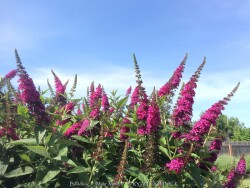

Butterfly Bush (Buddleia) are workhorses in the pollinator garden. Flower panicles come in a variety of colors mostly including shades of lavender, magenta, violet, pink, and white. Most Butterfly Bushes bloom on new wood so trimming off winter kill or complete rejuvenation will not affect flowering. In fact, flowering is often bigger and bolder from new water sprout growth when trimmed to the ground each year. Most Butterfly Bushes in zone 6 are maintained this way. Foliage is typically an attractive greenish-gray to mint green and persists into the fall until hard freezes occur. Use in the landscape in small or large groupings for its amazing flower power! Plants grow best in full sun with medium to dry soils. Drought tolerance is high with established plants so extra watering is rarely needed in our East Kansas climate with 40 inches of rain per year. Obviously, Butterfly Bush attracts lots of butterflies. There has been some debate in recent years on whether to plant Butterfly Bush because it's a non-native plant. Being a native of China, it has no pest or disease problems here. It is invasive in some parts of the country but cold Kansas winters keep it and check and without any self-seeding problems here. If you are still worried about it, there are several sterile varieties to choose from. There have been many drastically improved cultivars in the last 10 years aiming to improve cold hardiness, bloom size, eliminate seeding, and improve growth habits. Buddleia x 'Miss Molly' is a Proven Winners® plant With its intensely colored blooms and refined habit, 'Miss Molly' is the queen of the summer garden. Its fragrant flowers are the closest to red of any Butterfly Bush and appear for months every summer without deadheading. Unlike older varieties of Butterfly Bush, 'Miss Molly' reaches just 4-5' tall, so it's easy to work into any sunny landscape. This non-invasive variety thrives in hot climates. Butterflies and hummingbirds will find it as irresistible as you do! In Eastern Kansas, 'Miss Molly' has performs WELL for over 10 years with just about everything nature has to challenge it! Heat and drought are tolerated. Cold tolerance is no problem in our zone 6. If winter die-back occurs, cut back in March/April and flowers will occur on new growth in summer. No disease or pest problems. Combine with caryopteris and crapemyrtle to create a late season "all you can eat" buffet for pollinators! All Proven Winners® plants are legally propagated, healthy and vigorous, true to name, and tagged with color pictures and growing information.


Butterfly Bush (Buddleia) are workhorses in the pollinator garden. Flower panicles come in a variety of colors mostly including shades of lavender, magenta, violet, pink, and white. Most Butterfly Bushes bloom on new wood so trimming off winter kill or complete rejuvenation will not affect flowering. In fact, flowering is often bigger and bolder from new water sprout growth when trimmed to the ground each year. Most Butterfly Bushes in zone 6 are maintained this way. Foliage is typically an attractive greenish-gray to mint green and persists into the fall until hard freezes occur. Use in the landscape in small or large groupings for its amazing flower power! Plants grow best in full sun with medium to dry soils. Drought tolerance is high with established plants so extra watering is rarely needed in our East Kansas climate with 40 inches of rain per year. Obviously, Butterfly Bush attracts lots of butterflies. There has been some debate in recent years on whether to plant Butterfly Bush because it's a non-native plant. Being a native of China, it has no pest or disease problems here. It is invasive in some parts of the country but cold Kansas winters keep it and check and without any self-seeding problems here. If you are still worried about it, there are several sterile varieties to choose from. There have been many drastically improved cultivars in the last 10 years aiming to improve cold hardiness, bloom size, eliminate seeding, and improve growth habits. Buddleia x 'Pugster Amethyst' is a compact Butterfly Bush reaches just 2-3' tall and wide but has the large, full flowers normally seen on a much larger plant. It blooms non-stop from early summer through frost with amethyst-toned flowers, each with a tiny yellow-orange eye in the center. Thanks to thick, sturdy stems, the Pugster® series offers vastly improved hardiness and winter survival over other types of dwarf Butterfly Bush. Thanks to its long-blooming habit, Pugster Butterfly Bushes add low-maintenance color to any sunny spot in your yard. The name "Pugster" comes from these plants' resemblance to a pug - short, stocky, and cute! In Eastern Kansas, this cultivar performs WELL with just about everything nature has to challenge it! Heat and drought are tolerated. Cold tolerance is no problem in our zone 6. If winter die-back occurs, cut back in March/April and flowers will occur on new growth this year. No disease or pest problems. Combine with caryopteris and crapemyrtle to create a late season "all you can eat" buffet for pollinators! All Proven Winners® plants are legally propagated, healthy and vigorous, true to name, and tagged with color pictures and growing information.
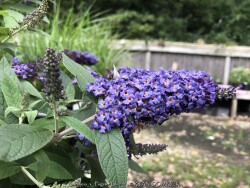

Butterfly Bush (Buddleia) are workhorses in the pollinator garden. Flower panicles come in a variety of colors mostly including shades of lavender, magenta, violet, pink, and white. Most Butterfly Bushes bloom on new wood so trimming off winter kill or complete rejuvenation will not affect flowering. In fact, flowering is often bigger and bolder from new water sprout growth when trimmed to the ground each year. Most Butterfly Bushes in zone 6 are maintained this way. Foliage is typically an attractive greenish-gray to mint green and persists into the fall until hard freezes occur. Use in the landscape in small or large groupings for its amazing flower power! Plants grow best in full sun with medium to dry soils. Drought tolerance is high with established plants so extra watering is rarely needed in our East Kansas climate with 40 inches of rain per year. Obviously, Butterfly Bush attracts lots of butterflies. There has been some debate in recent years on whether to plant Butterfly Bush because it's a non-native plant. Being a native of China, it has no pest or disease problems here. It is invasive in some parts of the country but cold Kansas winters keep it and check and without any self-seeding problems here. If you are still worried about it, there are several sterile varieties to choose from. There have been many drastically improved cultivars in the last 10 years aiming to improve cold hardiness, bloom size, eliminate seeding, and improve growth habits. Buddleia x 'Pugster Blue' is a compact Butterfly Bush reaches just 2-3' tall and wide but has the large, full flowers normally seen on a much larger plant. It blooms non-stop from early summer through frost with true-blue flowers, each with a tiny yellow-orange eye in the center. Thanks to thick, sturdy stems, the Pugster® series offers vastly improved hardiness and winter survival over other types of dwarf Butterfly Bush. Thanks to its long-blooming habit, Pugster Butterfly Bushes add low-maintenance color to any sunny spot in your yard. The name "Pugster" comes from these plants' resemblance to a pug - short, stocky, and cute! In Eastern Kansas, this cultivar performs WELL with just about everything nature has to challenge it! Heat and drought are tolerated. Cold tolerance is no problem in our zone 6. If winter die-back occurs, cut back in March/April and flowers will occur on new growth this year. No disease or pest problems. Combine with caryopteris and crapemyrtle to create a late season "all you can eat" buffet for pollinators! All Proven Winners® plants are legally propagated, healthy and vigorous, true to name, and tagged with color pictures and growing information.
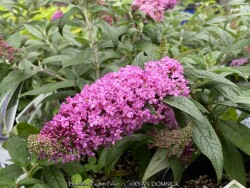

Butterfly Bush (Buddleia) are workhorses in the pollinator garden. Flower panicles come in a variety of colors mostly including shades of lavender, magenta, violet, pink, and white. Most Butterfly Bushes bloom on new wood so trimming off winter kill or complete rejuvenation will not affect flowering. In fact, flowering is often bigger and bolder from new water sprout growth when trimmed to the ground each year. Most Butterfly Bushes in zone 6 are maintained this way. Foliage is typically an attractive greenish-gray to mint green and persists into the fall until hard freezes occur. Use in the landscape in small or large groupings for its amazing flower power! Plants grow best in full sun with medium to dry soils. Drought tolerance is high with established plants so extra watering is rarely needed in our East Kansas climate with 40 inches of rain per year. Obviously, Butterfly Bush attracts lots of butterflies. There has been some debate in recent years on whether to plant Butterfly Bush because it's a non-native plant. Being a native of China, it has no pest or disease problems here. It is invasive in some parts of the country but cold Kansas winters keep it and check and without any self-seeding problems here. If you are still worried about it, there are several sterile varieties to choose from. There have been many drastically improved cultivars in the last 10 years aiming to improve cold hardiness, bloom size, eliminate seeding, and improve growth habits. Buddleia x 'Pugster Pinker' is the newest member of a unique series that offers full-sized flowers on dwarf plants. This compact Butterfly Bush reaches just 2-3' tall and wide but has the large, full flowers normally seen on a much larger plant. It blooms non-stop from early summer through frost with very rich pink flowers, each with a tiny bright orange eye in the center. Thanks to thick, sturdy stems, the Pugster® series offers vastly improved hardiness and winter survival over other types of dwarf Butterfly Bush. Thanks to its long-blooming habit, Pugster Butterfly Bushes add low-maintenance color to any sunny spot in your yard. The name "Pugster" comes from these plants' resemblance to a pug - short, stocky, and cute! In Eastern Kansas, this cultivar performs WELL with just about everything nature has to challenge it! Heat and drought are tolerated. Cold tolerance is no problem in our zone 6. If winter die-back occurs, cut back in March/April and flowers will occur on new growth this year. No disease or pest problems. Combine with caryopteris and crapemyrtle to create a late season "all you can eat" buffet for pollinators! All Proven Winners® plants are legally propagated, healthy and vigorous, true to name, and tagged with color pictures and growing information.
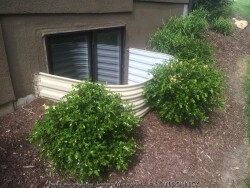

Boxwood (Buxus sp.) is a compact evergreen shrub with small round glossy green leaves. Originating in England and parts of Europe, there are many varieties ranging from small shrubs to small trees. Boxwood varieties grow rather slowly and lend themself excellently to being pruned into hedges as long as not too much is taken off at one time. After a plant achieves a certain height, you may keep it that size indefinitely with 3 to 4 times per year pruning. Boxwoods prefer part shade with rich to average well-drained soil and average moisture. Boxwoods planted in the full sun will survive but develop an burnt yellowish green color when temperatures exceed 100°F. This is usually a problem in zone 6 or further south as there are many better choices for full sun. (morning sun is okay) In zones 4-5, afternoon full sun is probably okay. Boxwoods are best known for their tolerance to dry shade even under root bound conditions. They will not survive more than a couple years under a roof overhang due to lack of moisture in the winter and spider mite problems. In the Eastern and Southeastern United States, Boxwoods have many problems including root rot, insect and disease issues. None of these are a problem in Kansas or Oklahoma with lower rainfall amounts and less humidity. In the landscape, yews offer a year-round structure. They definitely help provide a background for more interesting plants with colorful foliage and flowers. They are also very well known and used in formal garden designs. We prefer to see them less pruned and in their more natural state. Emerald Jewel Boxwood (Buxus microphylla var. koreana 'Emerald Jewel') has improved shinier light green spring foliage darkening by summer. Foliage maintains a "better" green in winter compared to other varieties. There is also no die back or twig blight problems like with Green Velvet Boxwood.
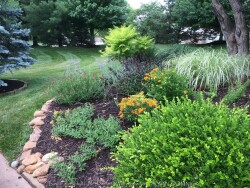

Boxwood (Buxus sp.) is a compact evergreen shrub with small round glossy green leaves. Originating in England and parts of Europe, there are many varieties ranging from small shrubs to small trees. Boxwood varieties grow rather slowly and lend themself excellently to being pruned into hedges as long as not too much is taken off at one time. After a plant achieves a certain height, you may keep it that size indefinitely with 3 to 4 times per year pruning. Boxwoods prefer part shade with rich to average well-drained soil and average moisture. Boxwoods planted in the full sun will survive but develop an burnt yellowish green color when temperatures exceed 100°F. This is usually a problem in zone 6 or further south as there are many better choices for full sun. (morning sun is okay) In zones 4-5, afternoon full sun is probably okay. Boxwoods are best known for their tolerance to dry shade even under root bound conditions. They will not survive more than a couple years under a roof overhang due to lack of moisture in the winter and spider mite problems. In the Eastern and Southeastern United States, Boxwoods have many problems including root rot, insect and disease issues. None of these are a problem in Kansas or Oklahoma with lower rainfall amounts and less humidity. In the landscape, yews offer a year-round structure. They definitely help provide a background for more interesting plants with colorful foliage and flowers. They are also very well known and used in formal garden designs. We prefer to see them less pruned and in their more natural state. Wintergreen Boxwood (Buxus microphylla var. koreana 'Wintergreen') has improved shinier light green spring foliage darkening by summer. Foliage maintains a "better" green in winter compared to other varieties. There is also no die back or twig blight problems like with Green Velvet Boxwood.
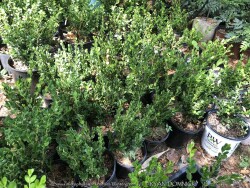

Boxwood (Buxus sp.) is a compact evergreen shrub with small round glossy green leaves. Originating in England and parts of Europe, there are many varieties ranging from small shrubs to small trees. Boxwood varieties grow rather slowly and lend themself excellently to being pruned into hedges as long as not too much is taken off at one time. After a plant achieves a certain height, you may keep it that size indefinitely with 3 to 4 times per year pruning. Boxwoods prefer part shade with rich to average well-drained soil and average moisture. Boxwoods planted in the full sun will survive but develop an burnt yellowish green color when temperatures exceed 100°F. This is usually a problem in zone 6 or further south as there are many better choices for full sun. (morning sun is okay) In zones 4-5, afternoon full sun is probably okay. Boxwoods are best known for their tolerance to dry shade even under root bound conditions. They will not survive more than a couple years under a roof overhang due to lack of moisture in the winter and spider mite problems. In the Eastern and Southeastern United States, Boxwoods have many problems including root rot, insect and disease issues. None of these are a problem in Kansas or Oklahoma with lower rainfall amounts and less humidity. In the landscape, yews offer a year-round structure. They definitely help provide a background for more interesting plants with colorful foliage and flowers. They are also very well known and used in formal garden designs. We prefer to see them less pruned and in their more natural state. Wintergreen Boxwood (Buxus microphylla var. koreana 'Wintergreen') has improved shinier light green spring foliage darkening by summer. Foliage maintains a "better" green in winter compared to other varieties. There is also no die back or twig blight problems like with Green Velvet Boxwood.
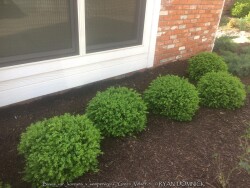

Boxwood (Buxus sp.) is a compact evergreen shrub with small round glossy green leaves. Originating in England and parts of Europe, there are many varieties ranging from small shrubs to small trees. Boxwood varieties grow rather slowly and lend themself excellently to being pruned into hedges as long as not too much is taken off at one time. After a plant achieves a certain height, you may keep it that size indefinitely with 3 to 4 times per year pruning. Boxwoods prefer part shade with rich to average well-drained soil and average moisture. Boxwoods planted in the full sun will survive but develop an burnt yellowish green color when temperatures exceed 100°F. This is usually a problem in zone 6 or further south as there are many better choices for full sun. (morning sun is okay) In zones 4-5, afternoon full sun is probably okay. Boxwoods are best known for their tolerance to dry shade even under root bound conditions. They will not survive more than a couple years under a roof overhang due to lack of moisture in the winter and spider mite problems. In the Eastern and Southeastern United States, Boxwoods have many problems including root rot, insect and disease issues. None of these are a problem in Kansas or Oklahoma with lower rainfall amounts and less humidity. In the landscape, yews offer a year-round structure. They definitely help provide a background for more interesting plants with colorful foliage and flowers. They are also very well known and used in formal garden designs. We prefer to see them less pruned and in their more natural state.
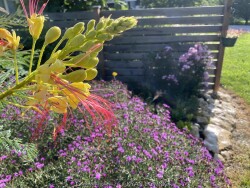

Hardy Bird of Paradise (Caesalpinia gilliesii) is a surprisingly hardy shrub from South America native to Argentina and Uruguay. The extremely fine textured bipennate foliage is fern-like and resembles Mimosa or Amorpha. During spring and summer the lovely foliage takes on a bluish green color. By late summer if conditions are optimal, beautiful flowers appear. The flowers are light yellow with protruding red hair-like stamens that are very showy, drawing in curious visitors. By late fall in our zone 6 climate, the foliage drops and typically the above ground woody part of the shrub freezes back and behaves like a Crapemyrtle or a Butterfly Bush. Trim dead growth in mid-spring and enjoy the new beautiful regrowth by early summer. In order for this shrub to flower, it needs to be well-established, in full sun, and preferably on the south or west side of a foundation. Hardy Bird of Paradise need average to dry well drained soil especially in the winter. Hardiness should not be an issue after seeing mature established plants at the Denver Botanic Garden (zone 5b) in full bloom. The Botanic Garden at Oklahoma State University (zone 7a) also has a few decades old specimens. Wet winter soils could limit its success in zone 5-7 areas in the Eastern United States. It has been thriving in our trial gardens and at several residential gardens in Lawrence, KS (zone 6a) 5-7 years ago. During the arctic blast of February, 2021, lows down to -17 degrees F on Feb 16th, 2021 were recorded. The longevity of this cold blast was also impressive: 10 days on a row with highs of 10-15 degrees F or lower, 8 nights of lows in the single digits and negatives, and 36 straight hours of 0 degrees F and mostly lower. It is virtually unknown in most garden centers but worthy of more wide-scale use especially in hot locations.
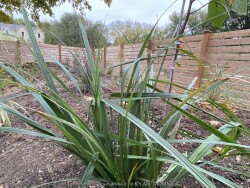

***Description for this grass available with future update!***Korean Feather Reed Grass, is also known as Calamagrostis brachytricha
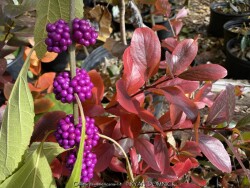

American Beautyberry (Callicarpa americana), native to Southeast US including Oklahoma and Missouri, is one of the most unique and attractive shrubs for berry production. Considered a three-season shrub, green foliage emerges in spring with attractive clusters of tiny pink flowers in summer. Big conglomerates of fruit clusters occur along the stem at evenly spaced intervals. Bright purple in color, the fruit is very effective through the month of October and November in our Zone 6a Kansas climate. Fall foliage is bright yellow often contrasting with the purple berries in November. By the following spring, winter kill to the ground will almost always occur as temperatures regularly drop to 0 degrees F or below. Cut to a few inches off the ground as you would with a perennial. You may choose to do this rejuvenation anyways in Southern areas if it has not been done in a few years to increase fruit production on vigorous new growth. New shoots create fountain-shaped shrub 3-4' after rejuvenation. Flowering occurs on new wood so you will always have berries when using this method. Purple berry clusters are highly ornamental and eaten only very slowly (never stripped clean) by birds. In southern parts of its range, full to part shade is best. However, full to part sun is recommended in zone 6 to maximize energy production needed from the sun in a shorter growing season. Mild drought is tolerated at the expense of dropping fruits if it gets too dry. Our plants in the display garden survived the winter of 2021 with temperatures reaching -16 degrees F coming up reliably from the ground each year. Overall, this is a great "woody perennial" for the Kansas landscape that is unfortunately often underused.
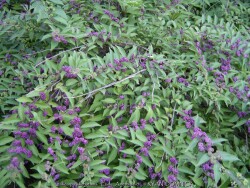

Purple beautyberry (Callicarpa dichotoma 'Early Amethyst'), native to Asia, is one of the most unique and attractive shrubs for berry production. Considered a three-season shrub, green foliage emerges in spring with attractive clusters of tiny pink flowers in summer. Big conglomerates of fruit clusters occur along the stem at evenly spaced intervals. Bright purple in color, the fruit is very effective through the month of October and November in our Zone 6a Kansas climate. Fall foliage is bright yellow often contrasting with the purple berries in November. The following spring, watch for winter kill if temperatures drop below -5 to -10 degrees F and be prepared to cut to a few inches off the ground. You may choose to do this rejuvenation anyways if it has not been done in a few years to increase fruit production on vigorous new growth. New shoots create fountain-shaped shrub 3-4' after rejuvenation. Flowering occurs on new wood so you will always have berries when using this method. Purple berry clusters are highly ornamental but rarely eaten (or stripped clean) by birds. Beautyberry grow best in part to full sun but can also tolerate almost full shade and still produce fruit. This makes them valuable for a north side of the house planting that only gets a couple of months of sun during the high sun angle peak of summer. Mild drought is tolerated at the expense of dropping fruits if it gets too dry. Our plants in the display garden survived without irrigation but did not fruit during the extreme drought of 2011. Overall this is a great plant for the landscape that is unfortunately often underused.
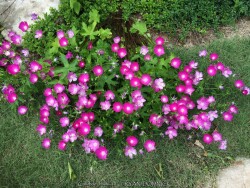

Upright Winecups (Callirhoe bushii) is also called Bush's Poppy Mallow. This plant grows from a carrot like taproot sporting a cluster of semi evergreen foliage around the base. In spring, new upright and prostrate growing vines spread in all directions along the ground up to 3 to 4 feet away from the taproot but do not root along the way. By late May or early June, magenta red "wine cup" shaped flowers cover this plant. The show last for about 4 to 6 weeks or until severe summer drought sets in. Usually in July, the flowering is complete and will set seed if allowed. Foliage will look bedraggled enough to justify complete cut back. This may be a good time to mulch unless you already mulched during the spring. When cooler weather returns in the fall, new growth emerges from the taproot looking attractive again. Secondary flowering may also occur in early fall.especially on summer planted plants. Bush's Poppy Mallow is a rare native wildflower of Missouri, Kansas, Arkansas and Oklahoma in rocky open woods and ravine bottoms. Bush's Poppy Mallow appreciates well drained soil and full to part sun. However we have found that it will still bloom and tolerate almost full shade (just a couple hours) if needed and our 40 inches of rain per year. A great plant for the top of a retaining wall, native pollinator gardens, or to even among other perennials to provide texture and contrast. It's one Achilles' heel is rabbits. Rabbits are usually only a problem in crowded suburbs where they have a little wild vegetation to eat and no predators. Gardeners with lots of established plants usually do not have rabbit problems. If rabbits are a problem for you, and you still want to grow upright wine cups, cover the plant with a bowl shaped piece of chicken wire attached with weed barrier pins. This will allow the taproot and basil foliage to get established the first year without any browsing (flowers may get eaten); after removing the cage the second year, the plants will generally outgrow any rabbit browsing. Other problems could be root rot but I have generally not seen that even in clay soils in Lawrence Kansas. Self seeding should be allowed to gently occur around the base of the plant to ensure a thick groundcover; these plants tolerate crowded conditions and will not crowd each other out or need division. This is one of the most iconic and beautiful native wildflowers!
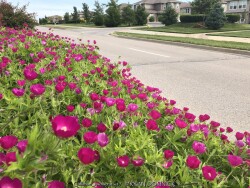

Wine cup (Callirhoe involucrata) is also called purple poppy mallow. This plant grows from a carrot like taproot sporting a cluster of semi evergreen foliage around the base. In spring, new prostrate growing vines spread in all directions along the ground up to 3 to 4 feet away from the taproot but do not root along the way. By late May or early June, magenta red "wine cup" shaped flowers cover this plant. The show last for about 4 to 6 weeks or until severe summer drought sets in. Usually in July, the flowering is complete and will set seed if allowed. Foliage will look bedraggled enough to justify complete cut back. This may be a good time to mulch unless you already mulched during the spring. When cooler weather returns in the fall, new growth emerges from the taproot looking attractive again. Secondary flowering may also occur in early fall.especially on summer planted plants. Poppy mallow winecup is a native plant of the great plains south to Texas and includes most of Kansas. As with most plants native to prairie areas, winecup appreciates well drained soil and full sun. However we have found that it will tolerate almost full shade if needed and our 40 inches of rain per year. A great plant for the top of a retaining wall, native pollinator gardens, or to even among other perennials to provide texture and contrast. It's one Achilles' heel is rabbits. Rabbits are usually only a problem in crowded suburbs where they have a little wild vegetation to eat and no predators. Gardeners with lots of established plants usually do not have rabbit problems. If rabbits are a problem for you, and you still want to grow wine cups, cover the plant with a bowl shaped piece of chicken wire attached with weed barrier pins. This will allow the taproot and basil foliage to get established the first year without any browsing; after removing the cage the second year, the plants will generally outgrow any rabbit browsing. Other problems could be root rot but I have generally not seen that even in clay soils in Lawrence Kansas. Self seeding should be allowed to gently occur around the base of the plant to ensure a thick groundcover; these plants tolerate crowded conditions and will not crowd each other out or need division. This is one of the most iconic and beautiful native wildflowers!


With its glossy burgundy-red foliage, Red Zeppelin sweetshrub (Calycanthus floridus var. purpureus) will rock your world! The color of the foliage lasts all season and is accompanied by lightly fragrant orange-red flowers in late spring and early summer. Not only is it adaptable and easy to grow in the landscape, but our many years of trialing indicate it’s easy to grow in production, too. This selection of our North American native species was developed by the folks at Pleasant Run Nursery. Prune after flowering to maintain shape. Calycanthus perform amazingly well in eastern Kansas landscapes. It is great along a woodland edge or in morning sun, or in full sun for best foliage color show. It tolerates a wide variety of soil types including clay but needs prefers well-drained soil high in organic matter. Adaptable to mild drought and heat but greatly improved with rich, moisture-retentive soils. Typically, our 40 inches of rainfall per year in Eastern Kansas is sufficient. Summer foliage is virtually pest-free. All Proven Winners® plants are legally propagated, healthy and vigorous, true to name, and tagged with color pictures and growing information.
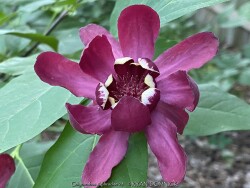

Aphrodite Sweetshrub (Calycanthus x 'Aphrodite') is covered in big, glossy, medium-green leaves. This shrub explodes with enormous cupped flowers that look a bit like a deep red magnolia. They start in early summer with a big flush of flowers continuing to bloom sporadically all summer long. This is a quite large shrub that needs plenty of space to look its best, but if you have the room for it, there are few better ways to use it! 'Aphrodite' is a hybrid between our native Calycanthus and the Asian species, x Sinocalycanthus. You're probably wondering if it's fragrant, and the answer is - it depends. The scent varies based on the age of the bloom, the time of day, and the flower itself. Some people say they smell like pineapple, others apples, others bubblegum, and some get no scent at all. Even if you never sense a whiff off this plant, its fabulous flowers are more than enough reward. Prune after flowering to maintain shape. This Calycanthus performs amazingly well in eastern Kansas landscapes. It is great along a woodland edge or in morning sun. When planted in full shade with rich soil in our Lawrence, KS Zone 6a display garden, growth is very rapid and flowers completely cover the shrub for a few weeks in early summer. Yes, you heard right, this shrub is will flower in full shade. It tolerates a wide variety of soil types including clay but needs prefers well-drained soil high in organic matter. Adaptable to mild drought and heat (plant in full shade in southern zones) but greatly improved with rich, moisture-retentive soils. Typically, our 40 inches of rainfall per year in Eastern Kansas is sufficient. Summer foliage is virtually pest-free. All Proven Winners® plants are legally propagated, healthy and vigorous, true to name, and tagged with color pictures and growing information.
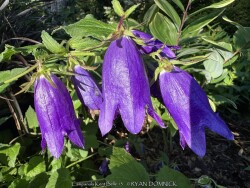

Blue Bellflower (Campanula sp.) is planted for its blue bell shaped flowers and attractive green foliage. Native to different parts of Europe. Generally this plant declines after a few years of Kansas climate but worth a try in perfect soils in well-tended part-shade gardens. Preferring northern climates, lack of moisture, alkaline soils, and competition with weeds seem to be an issue.
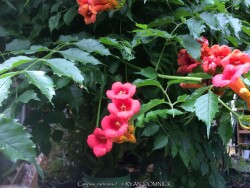

Trumpet vine (Campsis radicans) features shiny dark green foliage, orange-red trumpet-shaped summer flowers, green bean-like seed pods, and gold fall color. Flowers are very attractive to hummingbirds. Trumpet vine is native to the eastern United States including Kansas. Easily grown in a wide variety of soils including heady clay. It is usually grown on pergolas, trellises, and chain-link fences. Beware that this is an extremely vigorous plant that crowds out most weeds and is itself weed-like, with a very spreading growth habit. Best planted and allowed to grow in isolated areas or in horrible soils where no other plant will grow; mowing around it generally stops the yearly spread. Three beautifum mature plants in our display garden grow up posts on the North side of our covered awning behind our shop. They have been thriving for 15 plus years, growing in extremely compacted ab-3 gravel smashed into clay "soil" that is driven on by trucks and constantly walked on. A pick-axe will bounce off with each powerful swing! Now that is a tough "Once it's there, it's there forever" plant!
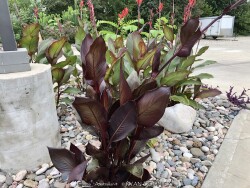

Cannas are typically grown for their continuous summer flowers and vertical wide-leaf foliage. The plants are large tropical and subtropical herbaceous perennials with a rhizomatous rootstock native to areas with a summer monsoon and dry winter. They can be grown as flowering summer patio plants. If growing as a potted plant and trying to overwinter, allowing the foliage to frost is ok, it will not kill the root system. However, do not allow the pot with rootball to freeze solid or go below 20 degrees for more than a few hours; move into a cold garage or basement over the winter with no watering. Cut back and allow to go dormant and place entire pot back out in April or May with a time-release fertilizer. Another more labor intensive way to overwinter cannas is to remove them from the dirt, dust with fungicide, place in box with sawdust, and keep in the refrigerator. We consider this method old-fashioned and too much work but ok if you only want to save a few pieces. If digging from the ground, just save a chunk with the dirt intact and place into a large pot in the garage. During the growing season, fertilize, water regularly, and place in full sun. You may also plant these in the ground for an enormous tropical effect! It is possible to overwinter these in the ground in Kansas by mulching 4-8" thick over deeply planted rhizomes. New growth will usually be slightly delayed but quick to regain full height. In our trial gardens in Lawrence, KS (zone 6a), the following varieties survived after being mulched 6-12" with leaf mulch to -17 degrees F. (Canna 'Daddy's Buckaroo',Canna 'Omega',Canna indica 'Red Stripe',Canna indica 'Ellen's Super Orange', Canna indica 'Wyoming') During the arctic blast of February, 2021, lows down to -17 degrees F on Feb 16th, 2021 were recorded. The longevity of this cold blast was also impressive: 10 days on a row with highs of 10-15 degrees F or lower, 8 nights of lows in the single digits and negatives, and 36 straight hours of 0 degrees F and mostly lower. Canna 'Australia' has maroon leaves and red flowers. This canna can also grow in standing water as a potted plant in water gardens or rain gardens.
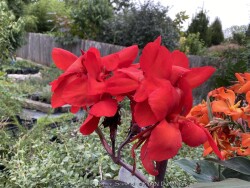

Cannas are typically grown for their continuous summer flowers and vertical wide-leaf foliage. The plants are large tropical and subtropical herbaceous perennials with a rhizomatous rootstock native to areas with a summer monsoon and dry winter. They can be grown as flowering summer patio plants. If growing as a potted plant and trying to overwinter, allowing the foliage to frost is ok, it will not kill the root system. However, do not allow the pot with rootball to freeze solid or go below 20 degrees for more than a few hours; move into a cold garage or basement over the winter with no watering. Cut back and allow to go dormant and place entire pot back out in April or May with a time-release fertilizer. Another more labor intensive way to overwinter cannas is to remove them from the dirt, dust with fungicide, place in box with sawdust, and keep in the refrigerator. We consider this method old-fashioned and too much work but ok if you only want to save a few pieces. If digging from the ground, just save a chunk with the dirt intact and place into a large pot in the garage. During the growing season, fertilize, water regularly, and place in full sun. You may also plant these in the ground for an enormous tropical effect! It is possible to overwinter these in the ground in Kansas by mulching 4-8" thick over deeply planted rhizomes. New growth will usually be slightly delayed but quick to regain full height. In our trial gardens in Lawrence, KS (zone 6a), the following varieties survived after being mulched 6-12" with leaf mulch to -17 degrees F. (Canna 'Daddy's Buckaroo',Canna 'Omega',Canna indica 'Red Stripe',Canna indica 'Ellen's Super Orange', Canna indica 'Wyoming') During the arctic blast of February, 2021, lows down to -17 degrees F on Feb 16th, 2021 were recorded. The longevity of this cold blast was also impressive: 10 days on a row with highs of 10-15 degrees F or lower, 8 nights of lows in the single digits and negatives, and 36 straight hours of 0 degrees F and mostly lower. Canna 'Cannova Bronze Scarlet' is a dwarf variety with reddish leaves and bright red flowers.
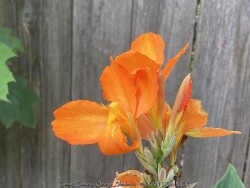

Cannas are typically grown for their continuous summer flowers and vertical wide-leaf foliage. The plants are large tropical and subtropical herbaceous perennials with a rhizomatous rootstock native to areas with a summer monsoon and dry winter. They can be grown as flowering summer patio plants. If growing as a potted plant and trying to overwinter, allowing the foliage to frost is ok, it will not kill the root system. However, do not allow the pot with rootball to freeze solid or go below 20 degrees for more than a few hours; move into a cold garage or basement over the winter with no watering. Cut back and allow to go dormant and place entire pot back out in April or May with a time-release fertilizer. Another more labor intensive way to overwinter cannas is to remove them from the dirt, dust with fungicide, place in box with sawdust, and keep in the refrigerator. We consider this method old-fashioned and too much work but ok if you only want to save a few pieces. If digging from the ground, just save a chunk with the dirt intact and place into a large pot in the garage. During the growing season, fertilize, water regularly, and place in full sun. You may also plant these in the ground for an enormous tropical effect! It is possible to overwinter these in the ground in Kansas by mulching 4-8" thick over deeply planted rhizomes. New growth will usually be slightly delayed but quick to regain full height. In our trial gardens in Lawrence, KS (zone 6a), the following varieties survived after being mulched 6-12" with leaf mulch to -17 degrees F. (Canna 'Daddy's Buckaroo',Canna 'Omega',Canna indica 'Red Stripe',Canna indica 'Ellen's Super Orange', Canna indica 'Wyoming') During the arctic blast of February, 2021, lows down to -17 degrees F on Feb 16th, 2021 were recorded. The longevity of this cold blast was also impressive: 10 days on a row with highs of 10-15 degrees F or lower, 8 nights of lows in the single digits and negatives, and 36 straight hours of 0 degrees F and mostly lower. Canna 'Cannova Orange Shades' is a dwarf variety with green leaves and bright orange flowers.
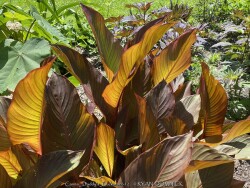

Cannas are typically grown for their continuous summer flowers and vertical wide-leaf foliage. The plants are large tropical and subtropical herbaceous perennials with a rhizomatous rootstock native to areas with a summer monsoon and dry winter. They can be grown as flowering summer patio plants. If growing as a potted plant and trying to overwinter, allowing the foliage to frost is ok, it will not kill the root system. However, do not allow the pot with rootball to freeze solid or go below 20 degrees for more than a few hours; move into a cold garage or basement over the winter with no watering. Cut back and allow to go dormant and place entire pot back out in April or May with a time-release fertilizer. Another more labor intensive way to overwinter cannas is to remove them from the dirt, dust with fungicide, place in box with sawdust, and keep in the refrigerator. We consider this method old-fashioned and too much work but ok if you only want to save a few pieces. If digging from the ground, just save a chunk with the dirt intact and place into a large pot in the garage. During the growing season, fertilize, water regularly, and place in full sun. You may also plant these in the ground for an enormous tropical effect! It is possible to overwinter these in the ground in Kansas by mulching 4-8" thick over deeply planted rhizomes. New growth will usually be slightly delayed but quick to regain full height. In our trial gardens in Lawrence, KS (zone 6a), the following varieties survived after being mulched 6-12" with leaf mulch to -17 degrees F. (Canna 'Daddy's Buckaroo',Canna 'Omega',Canna indica 'Red Stripe',Canna indica 'Ellen's Super Orange', Canna indica 'Wyoming') During the arctic blast of February, 2021, lows down to -17 degrees F on Feb 16th, 2021 were recorded. The longevity of this cold blast was also impressive: 10 days on a row with highs of 10-15 degrees F or lower, 8 nights of lows in the single digits and negatives, and 36 straight hours of 0 degrees F and mostly lower. Canna 'Daddy's Buckaroo' is a tall variety with reddish-green leaves and red-orange flowers. This variety is among the most cold hardy of the cannas due to its vigorous deep growing rhizomes. Our original plant came from Brian's Botanicals mail-order nursery in Kentucky.
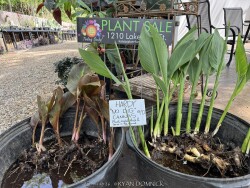

***Description for this plant available with future update!*** Canna 'No Dig' is also known as Mixed "No Dig" Winter Hardy Canna.
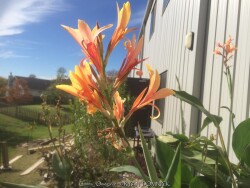

Cannas are typically grown for their continuous summer flowers and vertical wide-leaf foliage. The plants are large tropical and subtropical herbaceous perennials with a rhizomatous rootstock native to areas with a summer monsoon and dry winter. They can be grown as flowering summer patio plants. If growing as a potted plant and trying to overwinter, allowing the foliage to frost is ok, it will not kill the root system. However, do not allow the pot with rootball to freeze solid or go below 20 degrees for more than a few hours; move into a cold garage or basement over the winter with no watering. Cut back and allow to go dormant and place entire pot back out in April or May with a time-release fertilizer. Another more labor intensive way to overwinter cannas is to remove them from the dirt, dust with fungicide, place in box with sawdust, and keep in the refrigerator. We consider this method old-fashioned and too much work but ok if you only want to save a few pieces. If digging from the ground, just save a chunk with the dirt intact and place into a large pot in the garage. During the growing season, fertilize, water regularly, and place in full sun. You may also plant these in the ground for an enormous tropical effect! It is possible to overwinter these in the ground in Kansas by mulching 4-8" thick over deeply planted rhizomes. New growth will usually be slightly delayed but quick to regain full height. In our trial gardens in Lawrence, KS (zone 6a), the following varieties survived after being mulched 6-12" with leaf mulch to -17 degrees F. (Canna 'Daddy's Buckaroo',Canna 'Omega',Canna indica 'Red Stripe',Canna indica 'Ellen's Super Orange', Canna indica 'Wyoming') During the arctic blast of February, 2021, lows down to -17 degrees F on Feb 16th, 2021 were recorded. The longevity of this cold blast was also impressive: 10 days on a row with highs of 10-15 degrees F or lower, 8 nights of lows in the single digits and negatives, and 36 straight hours of 0 degrees F and mostly lower. Canna 'Omega' is a tall variety with blue-green leaves and orange flowers. This variety is the most cold hardy of the cannas due to its vigorous deep growing rhizomes. The rate of spread is faster so provide a larger space for this plant. This canna can also grow in standing water as a potted plant in water gardens or rain gardens.
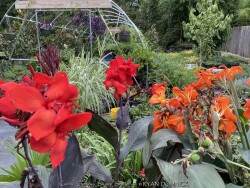

Cannas are typically grown for their continuous summer flowers and vertical wide-leaf foliage. The plants are large tropical and subtropical herbaceous perennials with a rhizomatous rootstock native to areas with a summer monsoon and dry winter. They can be grown as flowering summer patio plants. If growing as a potted plant and trying to overwinter, allowing the foliage to frost is ok, it will not kill the root system. However, do not allow the pot with rootball to freeze solid or go below 20 degrees for more than a few hours; move into a cold garage or basement over the winter with no watering. Cut back and allow to go dormant and place entire pot back out in April or May with a time-release fertilizer. Another more labor intensive way to overwinter cannas is to remove them from the dirt, dust with fungicide, place in box with sawdust, and keep in the refrigerator. We consider this method old-fashioned and too much work but ok if you only want to save a few pieces. If digging from the ground, just save a chunk with the dirt intact and place into a large pot in the garage. During the growing season, fertilize, water regularly, and place in full sun. You may also plant these in the ground for an enormous tropical effect! It is possible to overwinter these in the ground in Kansas by mulching 4-8" thick over deeply planted rhizomes. New growth will usually be slightly delayed but quick to regain full height. In our trial gardens in Lawrence, KS (zone 6a), the following varieties survived after being mulched 6-12" with leaf mulch to -17 degrees F. (Canna 'Daddy's Buckaroo',Canna 'Omega',Canna indica 'Red Stripe',Canna indica 'Ellen's Super Orange', Canna indica 'Wyoming') During the arctic blast of February, 2021, lows down to -17 degrees F on Feb 16th, 2021 were recorded. The longevity of this cold blast was also impressive: 10 days on a row with highs of 10-15 degrees F or lower, 8 nights of lows in the single digits and negatives, and 36 straight hours of 0 degrees F and mostly lower.